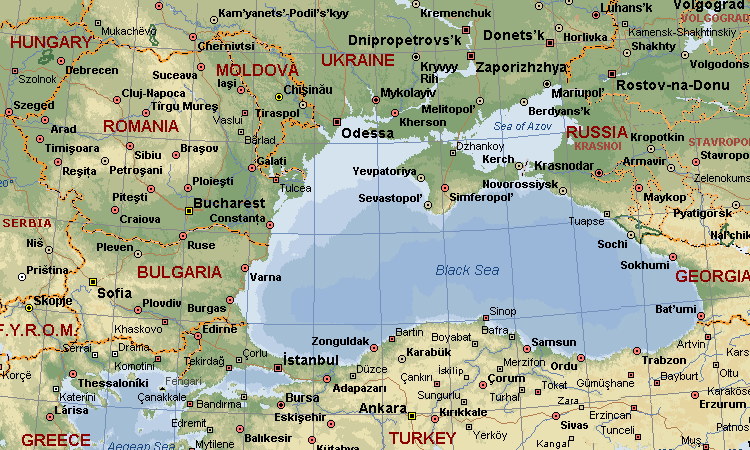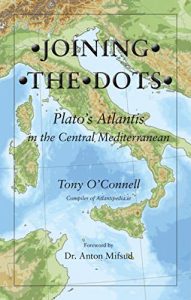Snake Island
Danube *
The River Danube is the second-longest river in Europe, which was known to the ancient Greeks as ‘Istros’. It rises in Germany’s Black Forest and after passing through many countries, including four capital cities, it eventually empties into the Black Sea.
A number of researchers have associated the river with Plato’s Atlantis. One of the earliest was Nicolae Densusianu who proposed that Atlantis had been situated in ancient Dacia, his native Romania. Over a century later some of his ideas have been revived by other Romanian commentators such as Adrian Bucurescu and Alexandra Furdui, who also translated Densusianu’s monumental work into English.
Densusian’s nationalism is now frowned upon and there is an understandable suspicion that his modern Romanian supporters may have similar underlying motivations.
There is a gorge on the Danube known as the Iron Gates which provides part of the boundary between Serbia and Romania. Densusianu located the Pillars of Heracles at the Iron Gates, an idea supported by Ticleanu, Constantin & Nicolescu at the 2008 Atlantis Conference, who place Atlantis further west on the Pannonian Plain [750.365]. In 2020, Veljko Milkovic also placed the ‘Pillars’ at the Iron Gates on the Danube and Atlantis in the Pannonian Basin(c) in his book Panonska Atlantida [1932].
However, Ranko Jakovlievic expressed the view that the Iron Gates section of the Danube was the location of Atlantis!
Related to this, is the claim by an anonymous ‘Sherlock’ that Pindar’s Olympian Ode 3 suggested that the Pillars of Herakles had been situated at the confluence of the Seva and Danube rivers near modern Belgrade(b).
A recent book [1742] by Antonije Shkokljev & Slave Nikolovski–Katin also recount an ancient version of the ‘Labours of Hercules’ that took place in the Balkans.
Christian and Siegfried Schoppe locate Atlantis east of the Danube Delta on Snake Island (Zimiinyi) in the Black Sea, an idea now adopted by George K. Weller(a). [Zimiinyi, Ukrainian territory, was occupied by the Russians 25.02.22 as part of their invasion of Ukraine]
Cahill, Michael A.
Michael A. Cahill (1961- ) is an Australian Lecturer in Biochemistry & Cell Biology, author of multiple patents, and scientific cofounder of the biotechnology company ProteoSys AG. He is also the author of an extensively researched two-volume work(b)(c), published in 2012, entitled Paradise Rediscovered: The Roots of Civilisation[818/9]. This offering of over 1100 pages is, by the author’s own admission, controversial. In it he puts forward the radical idea that “the long forgotten high society of Atlantis existed in the pre-Diluvian Stone Age at the mouth of the Black Sea [the location of present day Istanbul] and that its legends have come down to us in Indo-European and Middle Eastern mythologies (including the biblical Genesis account)”(d).
However Atlantis is only a tangent to main theme of this book, which opens with Solon in the Temple of Neith at Sais from Plato. Cahill recognised that the myth of Phaeton related by the old Egyptian priest actually referred to a supernova in the constellation of Cygnus. This was confirmation that the  Atlantis account referred to the transmission of actual historical information by Plato, rather than fictional imagination, inspired further investigation.
Atlantis account referred to the transmission of actual historical information by Plato, rather than fictional imagination, inspired further investigation.
For Cahill the inundation of Atlantis would have corresponded to the biblical Deluge, which Ryan and Pitman’s Noah’s Flood equated with the Black Sea Flood, dated at 6400 BC(e) after the breaching of the Bosporus. This date is around 1,200 years earlier than that suggested by Christian & Siegfried Schoppe, while Cahill’s proposed location for Atlantis, namely in the vicinity of modern Istanbul, is south of the Schoppe’s proposed Snake Island in the Black Sea. This location has, understandably, some local support from Adrian Bucurescu(g) and more recently from George K. Weller (h).
Linguistics analysis had suggested the origin of the Indo-European languages in Anatolia (i.e. next to the Black Sea) around 6400 BC. Cahill looked for and found otherwise unlikely traces of Indo-European words in flood accounts, such as Genesis, The Book of Enoch, and The Epic of Gilgamesh. He has published a summary of the arguments in a poster presented at the 2011 Atlantis Conference in Santorini, Greece. Based upon the society reconstructed from the written flood accounts, from Indo-European comparative mythology, and from a host of other sources, the book concludes that this society was dominated by god-kings who commanded secret scientific Neolithic knowledge, possibly including an elixir which extended the life-span of the elite(f).From the Stonehenge-like circular Atlantis complex at the Bosporus the “gods” exerted a monopoly on power until 200 of them defected, revealing secret knowledge to “the daughters of man” to start a new farming culture that spread across Europe with its Indo-European languages. Paradise Rediscovered certainly poses challenging questions for many established social and archaeological paradigms. Whether or not this shadowy reconstruction is correct, and even Cahill does not insist that it is(d), it is well researched and its elaborate arguments are surprisingly plausible. (The above synopsis was written by Cahill at my request. TO’C)
Cahill has had problems with selling his books through Amazon and offers an alternative source for purchasers(h).
(b) https://www.goodreads.com/book/show/15753858-paradise-rediscovered
(c) https://www.goodreads.com/author/show/6082558.Michael_A_Cahill
(d) https://www.amazon.com/Paradise-Rediscovered-Roots-Civilisation-ebook/dp/B0089C9OSU/
(e) https://www.researchgate.net/publication/265937032_Status_of_the_Black_Sea_flood_hypothesis
(f) https://www.dailyadvertiser.com.au/story/129886/lecturers-search-for-longer-life/
(g) https://sfinxredivivus.wordpress.com/tag/etnograful-adrian-bucurescu/
(h) https://www.goodreads.com/author_blog_posts/3147587-amazon-paperback-policy
Schoppe, Christian & Siegfried
Christian & Siegfried Schoppe are a father and son team of German researchers, who firmly assert that Atlantis was located in the Black Sea. More specifically they suggest that Snake Island(b) situated 35 km east of the Danube Delta, was the location of the Atlantean capital. Snake Island has also been referred to in a Russian website(c) that discusses a Black Sea Atlantis. It includes a number of video clips with Russian dialogue.
Snake Island has also been adopted by George K. Weller as the location of Atlantis(h).
Their contention is that before 5500 BC there was a great plain in the northwest of the area, now occupied by the Black Sea, which was then a much smaller freshwater lake. Atlantis in their view was situated on what was formerly the shore of this lake. The Schoppe’s echo the
view of Ryan and Pitman who were probably the first in 1998, to advance the idea that around 5500 BC the barrier at today’s Bosporus broke open due to the rising world sea levels and raised the level of the Black Sea, flooding a huge area of cultivated land, an event that lay behind the story of Noah’s Flood.
The Schoppes, on the other hand, identify this flooding of the Black Sea with the flooding of Atlantis and maintain that the Pillars of Heracles are located at the Strait of Bosporus. They further suggest that the Orichalcum mentioned by Plato was in fact obsidian that used to be a cash-equivalent at that time and was replaced by the spondylus shell around 5500 BC. This geocatastrophic event, according to the Schoppes, led to the Neolithic diaspora in Europe which also began around 5500 BC.>They also claim that included in that movement of refugees from Atlantis were the Vinca people(i).<
They also claim to have identified the location of the ten kingdoms of the Atlantean empire through an investigation of placenames for both meaning and sound. The theories of the Schoppe’s are contained in their book, Atlantis und die Sintflut [186] and outlined on their website(a).
In 2005, the Schoppes offered their theory to the Atlantis Conference on Milos and published their presentation online(g).
In June 2015, Siegfried Schoppe offered the latest paper in support of their Black Sea location for Atlantis(d) for publication on the Atlantipedia.ie website, as well as a shorter note, also in support of their theory(e).
In a short paper(f), the Schoppes also compared the effects of the fall of Rome with the consequences of the demise of Atlantis.
The Atlantis theory of the Schoppes, along with many others matches many of the clues offered by Plato, but for me, I find it difficult to understand how an Atlantis situated east of Athens and north of Egypt in the Black Sea could attack them from the west! In fact, what Plato said was that the invasion came from the Atlantic Sea (pelagos). Although there is some disagreement about the location of this Atlantic Sea, all candidates proposed so far are west of both Athens, Egypt and the Black Sea (Tim.24e & Crit.114c).
>Then, a few years ago the Schoppes suddenly and without explanation ‘closed shop’ and removed all their weblinks!<
(a) https://web.archive.org/web/20190830053312/https://www.black-sea-atlantis.com/black-sea-atlantis/
(b) https://en.wikipedia.org/wiki/Snake_Island_(Black_Sea)
(c) https://survincity.com/2010/04/conspiracy-theory-black-sea-atlantis-the-case-of/ (link broken Dec.2020)
(d) See: Archive 5098 (German)
(e) See: Archive 5099 (English)
(f) See: Archive 2873 (German/English)
(g) https://web.archive.org/web/20190819053202/https://www.black-sea-atlantis.com/milos.pdf
Black Sea
The Black Sea was known to the Greeks as the Euxine Sea and according to Strabo (1.2.10), in antiquity was often simply referred to as “the sea” (pontos). It has also been known as the Scythian Sea after the people who lived on its northern shore. Pindar referred to it as the ‘Inhospitable Sea’.
It received little attention in connection with the Atlantis mystery until the 19th century when two French writers, André de Paniagua and Moreau de Jonnès, independently located Atlantis in the Sea of Azov. Some years later in 1923, R.A. Fessenden, a Canadian professor of  Mathematics and Electrical Engineering wrote about the prehistoric flooding of a civilisation in the Caucasus region, which he linked with Plato’s Atlantis. The text of this extensive work is now available on the Internet(a).
Mathematics and Electrical Engineering wrote about the prehistoric flooding of a civilisation in the Caucasus region, which he linked with Plato’s Atlantis. The text of this extensive work is now available on the Internet(a).
Trevor Palmer has written a useful paper (2009) on the Black Sea and the gradual development of theories relating to its dramatic connection with the Mediterranean and how it may have influenced the mythologies of the Middle East and possibly further afield.
Palmer concluded that “The various groups currently investigating the area are agreed that cataclysmic flooding took place during the Late Pleistocene, but remain divided about whether similar floods also occurred during the Holocene. Eye-witness accounts of catastrophic floods in the Black Sea basin at either time could have been passed on to future generations, eventually giving rise to the later Mesopotamian legend of Uta-napishtim and, subsequently, the Biblical story of Noah. However, in the absence of any direct evidence of cultural transmission, that can presently only be regarded as plausible speculation.”(p)
Little was heard of the region again until 1998 when Ryan & Pitman identified the flooding of the Black Sea with Noah’s Flood[025]. This was followed in 2001 by Ian Wilson‘s Before the Flood [185], which reflected a similar line of thought.
In 2004, the Bulgarian father and son oceanographers, Petko and Dimitar Dimitrov published their book, The Black Sea, the Flood and the Ancient Myths, in English, which supported much of Ryan and Pitman’s work. Unlike them, who based much of their conclusions on a study of molluscs, the Dimitrovs focused on sedimentation evidence. Their book is now available, in English, as a free pdf file(d). They also suggest that this Holocene influx into the Black Sea also triggered the Vedic Aryan migration to India(g).
Hristo Smolenov is another Bulgarian and a recognised expert in counter-terrorism and mathematics and is another advocate of a Black Sea Atlantis, which he identifies with what he calls the Aurolithic Varna Civilisation that existed 3,000 years before the pyramids. Varna today is situated in the Bulgarian province of Stara Zagora on the Black Sea coast. He has publicised his views through a website(r), video(s) and a book [1003], Zagora – Varna: The Hidden Superculture.
Ryan and Pitman’s book unintentionally triggered the imaginations of a number of people into considering the possibility of a possible link between this inundation and the sinking of Atlantis. While Ryan and Pitman have made no such suggestion, others such as Ian Wilson[185] have seen a distorted memory of the event as a possible inspiration for Plato’s story. In 2009, Liviu Giosan, a geologist at the Woods Hole Oceanographic Institute published a paper(e) which suggested that prior to the intrusion of the Mediterranean, the level of the Black Sea had been just 30 metres below its present level rather than the 80 metres proposed by Ryan and Pitman. This would imply a less extensive degree of flooding than previously thought. Giosan has offered a sceptical Ryan an opportunity to replicate his tests.
Although the scenario pictured by Ryan & Pitman and others is of very rapid flooding of the original smaller Black Sea, more recent studies appear to indicate a more gradual rising of the water levels. “With more data to be analysed, it supports the idea that the waters rose unnoticeably, by metres over centuries, even millennia.”(o)
Nick Thom, a British engineer, wrote The Great Flood [776] which includes a section on the Black Sea in which he suggests that the flow of water was from the Black Sea into the Sea of Marmara rather than the other way around.
Nearly two hundred years ago Josiah Priest in his 1835 book American Antiquities [1143] also offered evidence from Euclid of Megara that the flow of water had been from the Black Sea to the Aegean. Apparently, Euclid heard this from Anacharsis a philosopher from the northern coast of the Black Sea related how the inflow from the rivers of Europe and Asia raised the level of the ‘Sea’ until it breached the landbridge and spilled over into the Sea of Marmara.
Paul Dunbavin has entered the Black Sea flood(s) debate with a 2020 paper entitled Diodorus Siculus and the Black Sea Flood(q). This lengthy essay covers a lot of ground, in particular the comments of Diodorus Siculus who described a Samothracian flood story that appears to contradict the flood described by Ryan & Pitman as it describes a flow of water in the opposite direction. Consequently, the evidence offered by Diodorus is often discounted as ‘unreliable’. Dunbavin, however, offers a possible solution with the suggestion that “The Samothracian flood, as described by Diodorus, could only have occurred after the Black Sea Flood.”
>The question of whether the Black Sea Flood was from the east or the west may be answered by consideration of Ronnie Gallagher’s claim of a vast post-glacial Eurasian sea that included the Caspian and Aral Seas. Modern proponents of Atlantis in the Sea of Azov have suggested(t) that at the end of the last Ice Age floods of meltwater poured into the Caspian Sea, which in turn escaped through the Manych-Kerch Gateway(u) into what is now the Sea of Azov, but at that time contained the Plain of Atlantis and from there to the Black Sea proper! This theory suggests that the flooding came from the Black Sea into the Aegean.<
More recently, Christian & Siegfried Schoppe, two German researchers have also asserted that the Black Sea was the original ‘Atlantis Ocean and that Atlantis was located in that region [186]. They have suggested that Snake Island located east of the mouth of the Danube was the probable site of Plato’s city. Their contention is that around 5500 BC a landbridge at the Bosporus was breached causing extensive flooding that created what we now know as the Black Sea. Until that time there had only been a small freshwater lake in the region. Although their book was published in German, the Schoppes have a website(b) with a useful amount of English content.
 The somewhat eccentric duo of the late Flying Eagle (1920-2007) and Whispering Wind, who also advocated a Black Sea location for Atlantis(a)(f), claimed a specific site on the Strait of Kerch between the Black Sea and the Sea of Azov. Their theory was first expounded in their book [138] in 2004. They also followed the Ryan and Pitman date of 5500 BC for the inundation of the Black Sea.
The somewhat eccentric duo of the late Flying Eagle (1920-2007) and Whispering Wind, who also advocated a Black Sea location for Atlantis(a)(f), claimed a specific site on the Strait of Kerch between the Black Sea and the Sea of Azov. Their theory was first expounded in their book [138] in 2004. They also followed the Ryan and Pitman date of 5500 BC for the inundation of the Black Sea.
The evidence to date suggests that the flooding of the Black Sea coincided with a storegga event, which would require a catastrophe on a scale not previously considered. In a 2017 paper(i), John M. Jensen offers a range of evidence to support this contention.
A rather different approach is taken by the German researcher Werner E. Friedrich[695], who pushes back the expansion and the raising of the level of the Black Sea to around 10000 BC, at the end of the last Ice Age. He believes that this led to the flooding of Atlantis, which he claims to have been situated on a plain that had lain between ancient extensions of the rivers Donau and Don. Friedrich located the Pillars of Heracles in the Sea of Marmara[p.39].
A.I. Zolotukhin places Atlantis in western Crimea on his multilingual website with the inviting title of Homer and Atlantis(j).
The legendary destroyed city of Ancomah is frequently compared to Plato’s description of the destruction of Atlantis. It was reputed to have existed in the vicinity of the ancient port city of Trabzon, which is located on the southeast coast of the Black Sea.
Michael A. Cahill in his 2012 two-volume[818][819] publication on the development of civilisation locates Atlantis near what is modern Istanbul in the pre-Diluvian Stone Age.
The concept of a Black Sea Atlantis has the support of the rather eccentric Church of Vrilology(h)!
In October 2018, an attempt was made to breathe new life into the idea of Crimea as a remnant of an Atlantis submerged under the Black Sea. Unfortunately, it offers no evidence or references in the badly translated article(k). In the same month, it was reported that the oldest intact shipwreck was discovered in the Black Sea by an Anglo-Bulgarian team. It was identified as a Greek trading vessel dated to 400 BC(l). The oxygen-free waters at the bottom of the Black Sea had preserved it and dozens of others located by the team.
In early 2019, George K. Weller, building on the theories of the Schoppes, also proposed the Black Sea as Atlantis’ home, again nominating Snake Island as the home of Mr. and Mrs. Poseidon, which, before the Black Sea was flooded, would have been the central peak of their island home, as referred to by Plato(n).
One of the most comprehensive internet papers on all aspects of the history of the Black Sea can be found on the Encyclopaedia Iranica website(m).
(a) https://www.radiocom.net/Deluge/Deluge1-6.htm
(b) See: https://atlantipedia.ie/samples/archive-3914/
(d) http://io-bas.bg/noahproject/BOOK_PETKO.pdf
(f) https://atlantis-today.com/Great_Atlantis_Flood.htm
(h) https://web.archive.org/web/20130108091223if_/https://www.vrilology.org/Atlantis_page.htm
(i) https://www.migration-diffusion.info/article.php?year=2017&id=505
(j) https://homerandatlantis.com/?lang=en
(k) https://ktelegram.com/scientists-crimea-may-be-a-fragment-of-the-lost-city-of-atlantis/43728/ (link broken Jan. 2019)
(m) https://www.iranicaonline.org/
(o) https://www.bbc.com/travel/story/20191021-the-sea-of-60-ghostly-wrecked-ships
(q) e5604c_67fd983e0b934a56ac5b31ee9dd1f41e.pdf (third-millennium.co.uk)
(r) https://atlantisblacksea.wordpress.com/tag/hristo-smolenov/
(s) https://atlantisblacksea.wordpress.com/atlantis-in-the-black-sea-videos/


